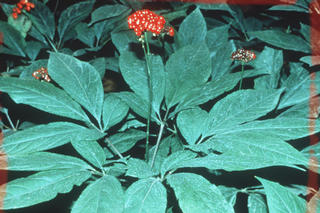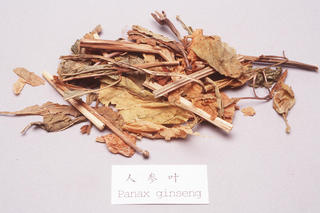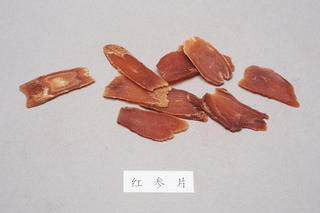Panax ginseng
Contents
Nomenclature
Other Names:
Historical Use of Panax ginseng
Panax ginseng in Traditional Chinese Medicine
Background
Chinese Name (pinyin): Renshenye
Chinese Name :
Common Name :Ginseng Leaf
Specific Name : Folium ginseng
Scientific Name:
Collection : The drug is collected in autumn and dried in the air or baked.
Description : Usually in small bundles, sheaf shaped or fan shaped, 12 - 35cm long, leaves palmately compound, long petioled, dark green, 3 - 6verticillate. Leaflets usually 5 or 8. Ocassionally 7 or 9, ovate or obovate, the basal ones 2 - 8cm long, 1 - 4cm wide, the upper ones similar in size, 4 - 16cm long, 2 - 7cm wide, cuneate at the base, acuminate at the apex. Margins serulate and bristly, veins on the upper surface bristly and veins on the lower surface prominent. Texture papery, easily broken, odor, delicately aromatic, taste slightly bitter and sweet.
Identification : 1.Powder: Yellowish green, upper epidertmal cells irregular, nearly rectangular, 35 - 92µm long, 32 - 60µm wide with sinuous or deep sinuous anticlinal walls. Lower epidermal cells similar to upper epidermis, relatively small, stomata anomocytic, subsidiary cells 31 - 35µm long. Palisade tissue absent, mesophyll consisting of 4 layers of subrounded parenchymatous cells, 18 - 29µm in diameter, containing chloroplast or clusters of calcium oxalate, 12 - 40µm in diameter, acutangular.2.Moisten 0.2g of powder in a 10ml stoppered test tube with 1ml of water, add 5ml of n-butanol saturated with water, mix well by shaking, place the tube at room temperature for 48 hours. To one part of the clear upper layer solution add 3 parts of n-butanol saturated with water, mix well by shaking, allow to stand until tow layers are separated (centrifuge if necessary) take the upper layer as the test solution. Dissolve ginsenoside Rg1 and Re CRS in methanol to produce a solution containing 2.5mg of each per ml as the reference solution. Carry out the method of thin layer chromatography (appendix Vl B) using silica gel G as the coating substance and the upper layer of n-butanol-ethyl acetate-water (4:1:5) as the mobile phase. Apply separately to the plate 10µl of each of the two solutions. After developing and removal of the plate, dry it in the air, spray with solution of sulfuric acid (1?10), dry at 105ºC for 15 minutes, examine under daylight and ultra violet light (365nm). The spots in the chromatogram obtained with the test solution correspond in position and colour to the spots in the chromatogram obtained with the reference solution.
Processing :
Action : To nourish qi and lung, expel summer-heat, to promote fluid secretion.
Indication : cough due to deficiency of qi, dysphoria due to summer heat, thirst due to impairment of body fluid, lassitude of limbs
Precautions : Incompatible with Rhizoma et Radix Veratri.
Dosage : 3 to 9 g.
Storage : Preserve in a cool and dry place, protected from moisture.
Nomenclature
Other Names:
Historical Use of Panax ginseng
Panax ginseng in Traditional Chinese Medicine
Background
Baishen °×²Î
Biezhishen ±ðÖ±²Î
Dalishen ´óÁ¦²Î
Hongshen ºì²Î
Jilinshen ¼ªÁÖ²Î
Liaodongshen Áɶ«²Î
Renshenxu È˲ÎÐë
Chinese Name (pinyin): Renshen
Chinese Name :
Common Name :Ginseng
Specific Name : Radix ginseng
Scientific Name:
Collection : The drug is collected in autumn and washed clean., Sun dried or baked dried Yuanshen is known "Shengshaishen" (sundried Ginseng). Sun dried Sanshen is known as "Shengshaishanshen" (sun dried wild ginseng)
Description : Sun dried Ginseng: Main roots fusiform or cylindrical, 3 - 15 cm in diameter. Externally greyish yellow, upper part or entire root exhibiting sparse, shallow, interrupted and coarse transverse striations and distinct longitudinal wrinkles. Lower part bearing 2 - 3 branch roots and numerous slender rootlets with inconspicuous minute tubercles. Rhizomes (Lutou), 1 - 4 cm long, 0.3 - 1.5 cm in diameter, mostly constricted and curved bearing adventitious roots (Ding) and showing sparse depressed circular stem scars (Luwan). Texture relatively hard, fracture yellowish white, starchy, cambium ring brownish yellow, bark exhibiting yellow-brown dotted resin canals and radial clefts. Odour characteristic, taste slightly bitter and sweet.Sun-dried Wild Ginseng: Main roots long as or shorter than rhizome. -shape, rhomboid or cylindrical, 2 - 10 cm long, externally greyish yellow, longitudinally wrinkled, upper end with dense deep depressed annulations, branch roots mostly 2, rootlets slender, orderly arranged or showing some distinct warts known as " pearl like knot" (Zhenzhugeda). Rhizomes slender, the upper part exhibiting dense stem scars, adventitious roots relatively thick like a kernel of Chinese date.
Identification : 1.Transverse section: Cork consisting of several rows of cells. Cortex narrow, phloem showing cleft in the outer part and parenchymatous cells densely arranged and scattered with resin canals containing yellow secretions in the inner part. Cambium in a ring. Xylem rays broad. Vessels soingly scattered or grouped, interruptedly arranged radially, occasionally accompanied by nonlignified fibres. Parenchymatous cells containing clusters of calcium oxalate.Powder of Sun-dried Ginseng: Yellowish white fragments or resin canals containing yellow masses of secretion. Clusters of calcium oxalate 20 - 68 µm in diameter with acute angles. Cork cells subsquare or polygonal with thin and sinuous walls. Reticulate and scalariform vessels 10 - 56 µm in diameter. Starch granules fairly abundant, simple granules subspheroidal, semi-circular or irregular polygonal. 4 - 20 µm in diameter, hilum pointed or slit-shaped. Compound granules of 2 - 6 components.2.To 0.5g of the powder add 5 ml of ethanol, shake for 5 minutes, filter. Evaporate a small quantity of filtrate to dryness in evaporating dish. Add drtopwise a saturated solution of antimony trichloride in chloroform, evaporate to dryness again, a violet colour is produced3.To 1 g of the powder add 40 ml of chloroform, heat under reflux on a water bath for 1 hour. Discard the chloroform layer. Evaporate the residue to dryness. Moisten the residue with 0.5 ml of water. Add 10 ml of n-butanol saturated with water, ultrasonicate for 30 minutes. To the supernatant liquid add 3 volumes of ammonia TS, mix well, allow to stand. Evaporate the supernatant liquid to dryness. Dissolve the residue in 1 ml of methanol as the test solution. Prepare a solution of 1 g of Radix Ginseng reference drug in the same manner as the reference drug solution. Dissolve ginsenosides Rb1, Re, Rg1 in methanol to produce a solution containing each 2 mg per ml as the reference solution. Carry out the method for thin layer chromatography (Appendix Vl B) using silica gel G as the coating substance (500µm thick) and chlorofrom-ethyl-acetate-methanol-water (15:40:22:10) as the mobile phase. Apply separately to the plate 1 - 2 µl of each of the three solutions. After developing and removal of the plate, dry it in the air. Spray with 10% solution of sulfuric acid in ethanol. Heat at 105ºC for several minutes. Examine under sunlight and ultra violet light (365 nm). The spots of fluorescent in the chromatogram obtained with the test solution correspond in position and colour to the spot to the in the chromatogram obtained with the reference drug solution. The three purplish red spots in the chromatogram obtained with the test solution under sunlight correspond in position and colour to the spots in the chromatogram obtained with the reference solution. A yellow and two orange fluorescent spot in the chromatogram obtained with the test solution under ultra violet light (365 nm) correspond in position and colour to the spots in the chromatogram obtained with the reference solution
Processing : Sun dried Ginseng: Soften thoroughly, cut into slices and dry.Sun dried Wild Ginseng: Pulverized or break to pieces before use.
Action : To reinforce the vital energy, to remedy collapse and restore the normal pulse, to benefit the spleen and lung, to promote the production of body fluid, and to calm the nerves.
Indication : Prostration with impending collapse marked by cold limbs and faint pulse, diminished function of the spleen with loss of appetite, cough and dyspnea due to diminished function of the lung, thirst due to impairment of body fluid or diabetes caused by internal heat, general weakness with irritability and insomnia in chronic diseases, impotence or frigidity, heart failure, cardiogenic shock
Precautions : Incompatible with Rhizoma et Radix Veratri.
Dosage : 3 to 9 g.
Storage : Preserve in well closed containers, stored in a cool and dry place, protected from moth.
Nomenclature
Other Names:
Historical Use of Panax ginseng
Panax ginseng in Traditional Chinese Medicine
Background
Chinese Name (pinyin): Hongshen
Chinese Name :
Common Name :Red Ginseng
Specific Name : Radix ginseng rubra
Scientific Name:
Collection : The drug is collected in autumn, wash clean, steamed and dried.
Description : Main roots fusiform or cylindrical, 3 - 10 cm long. 1 - 2 cm in diameter, externally translucent, reddish brown, occasionally exhibiting a few dark yellowish brown patches, furrowed longitudinally wrinkled and rootlet scars, upper part exhibiting interrupted indistinct annulations. Lower party bearing 2 - 3 twisted intersected branch root and numerous curved rootlets or just showing depressed-circular stem scars (Luwan), some bearing 1 -2 entire or broken adventitious roots (Ding). Texture hard and fragile, fracture even, horny. Odour delicate fragrant and characteristic, taste sweet and slight bitter.
Identification : 1.Carry out the method for Identification test (1) in the monograph of Radix Ginseng. It shows the same characteristics except the starchy granule.2.Carry out the method for Identification test (2) and (3) in the monograph of Radix Ginseng. It shows the same result.
Processing : Soften thoroughly, cut into thin slices and dry. Break to pieces before use.
Action : To replenish vital essence, promote blood circulation and relieve collapse. To reinforce qi and to stanch bleeding.
Indication : prostration with impending collapse marked by cold limbs and faint pulse; hemorrhagy due to exhaustion of qi; metrorrhagia and metrostasis; heart failure; cardiogenic shock
Precautions : Incompatible with Rhizoma et Radix Veratri.
Dosage : 3 to 9 g.
Storage : Preserve in well closed containers, stored in a cool and dry place, protected from moth.
Synonymns for Panax ginseng
Patent Medicines and Medicines with Multiple Ingredients that include Panax ginseng
Pharmaceutical Information
Chemical Constituents
Evidence or the Use of Panax ginseng in the Treatment of Epilepesy
Basic Science
Animal Studies
Cohort, Case-Control and Non-Randomized Trials
Randomized Controlled Trials
Meta-Analysis
1st Five Results: pubmed search
Jie Du, Zhengwei Huang, Chun Li, Ling Jiang
Quantitative analysis of the illegal addition of Atenolol in Panax notoginseng based on NIR-MIR spectral data fusion and calibration transfer.
RSC Adv: 2024, 14(18);12428-12437
[PubMed:38633489]
[WorldCat.org]
[DOI]
(I e)
Jiaqing Wu, Jinyu Liu, Junwei Sun, Yingpin Liu, Tao He, Jing Zhao, Xinyue Mei, Yixiang Liu, Min Yang, Shusheng Zhu
##Title##
J Agric Food Chem: 2024;
[PubMed:38632108]
[WorldCat.org]
[DOI]
(I a)
Liang Hu, Jun He, Ting Zhang, Shijie Pan, Hong Zou, Kequan Lian, Jincai Guo, Tang Qun
Panax notoginseng saponins improve oral submucous fibrosis by inhabiting the Wnt/β-catenin signal pathway.
Oral Surg Oral Med Oral Pathol Oral Radiol: 2024;
[PubMed:38632037]
[WorldCat.org]
[DOI]
(I a)
Yuxin Bai, Guangzhi Cai, Na Guo, Xin Huang, Jiyu Gong, Shuying Liu, Yunlong Guo, Wei Wang
##Title##
Food Sci Biotechnol: 2024, 33(7);1685-1696
[PubMed:38623439]
[WorldCat.org]
[DOI]
(I e)
Yanan Hu, Qiuyang Fan, Bo Qiao, Ou Xu, Bijun Lv, Niping Han, Xiaomei Zhang
##Title##
COPD: 2024, 21(1);2329282
[PubMed:38622983]
[WorldCat.org]
[DOI]
(I p)


